Block 11 at Auschwitz I
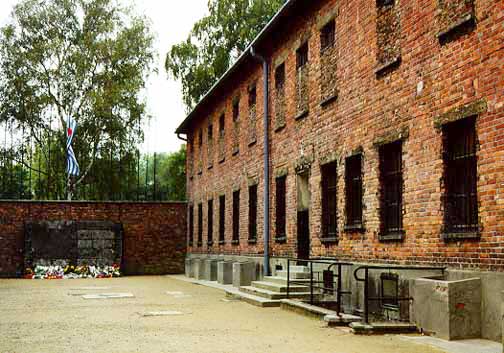 Block 11 with bars
on windows and upper windows bricked up
Block 11 with bars
on windows and upper windows bricked up
Pictured above is the prison building
in Auschwitz I, known as Block 11, located inside a walled courtyard.
It was here that prisoners from Auschwitz I and Auschwitz II
(Birkenau) were brought for punishment for what the Nazis considered
serious offenses, such as sabotage in the Auschwitz factories
or attempting to escape. It was also where political prisoners
from outside the camp were housed while they awaited trial in
the courtroom of the Gestapo Summary Court which was also in
this building.
The photograph above was taken in 1998,
from inside the courtyard between Block 11 and Block 10. It shows
one side of the prison building at Auschwitz I, known as Block
11. On the left is the black wall where prisoners were executed
after being convicted in the courtroom that was located in Block
11.
In the photo above, one can see the concrete
wells placed around the basement windows so the prisoners in
the cells below could not see out, but some light could enter
through the open top of the well. Note that some of the cells
have no well around the window. One of these cells is the one
where Father Maximilian Kolbe, a Polish priest, was left to die
of starvation, after he volunteered to take the place of a condemned
Polish political prisoner.
The windows on the ground floor have
bars on them; there were dormitories with three-tiered bunk beds
in these rooms where prisoners lived while awaiting trial. The
upper floor window openings have been closed up with bricks with
only a small window left at the top.
On the other side of Block 11 is the
gravel pit which was used as an execution site for Polish Catholic
political prisoners. The gravel pit is where, in 1988, Carmelite
nuns placed the 26-foot souvenir cross from the Mass said by
the Pope at Auschwitz II in 1979. The photograph below, taken
in October 2005, shows the former gravel pit, now covered with
grass, with the Block 11 building in the background. Note the
window openings which have been bricked up.
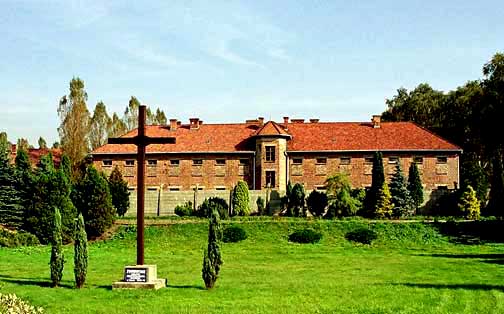 Block 11 as seen from
outside the camp
Block 11 as seen from
outside the camp
The large cross, shown in the photo above,
was used by Pope John Paul II when he said Mass for 500,000 people
at the Birkenau camp in 1979. The grass in the foreground covers
the former gravel pit where 152 Polish political prisoners were
executed by the Nazis.
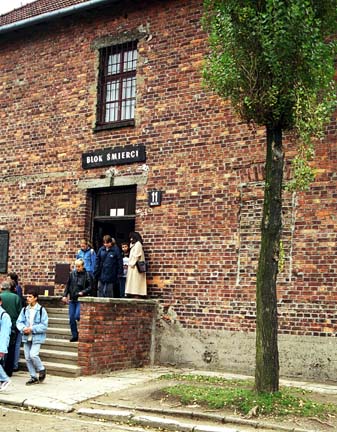 Front entrance to Block
11, the prison block
Front entrance to Block
11, the prison block
When I visited Block 11 in October 2005,
there was a souvenir stand in the wooden building shown in the
photo below. This building was the "New Laundry," according
to the camp guidebook. It is across the street from the entrance
to Block 11. Behind the laundry is the former theater building,
which was used for storage of the property taken from the prisoners
when they arrived.
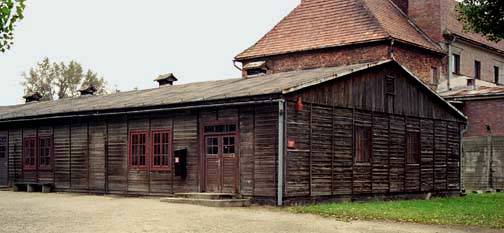 1998 photo of building
which now has a souvenir stand
1998 photo of building
which now has a souvenir stand
The sign with the skull and crossbones,
shown below, has been photographed many times; it is almost as
famous as the Arbeit Macht Frei gate at Auschwitz I. It stands
in front of the fence at the end of the street where Block 11
is located, and is just to the right of the Block 11 building,
shown in the photo above. As you can readily see, this sign,
which was put up almost 60 years ago, had faded considerably
by 1998. When I visited again in 2005, the sign looked as if
it had been repainted.
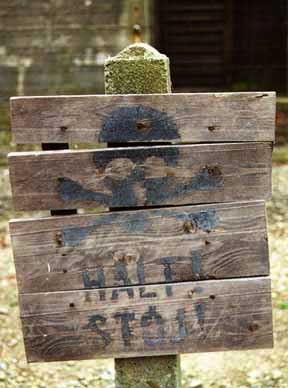 Warning sign in front
of electrified fence near Block 11
Warning sign in front
of electrified fence near Block 11
|